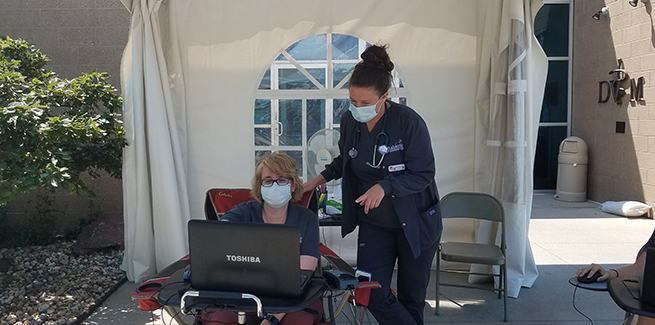Pandemic-proofing your hospital

Veterinary practices had to pivot fast this past spring. The transition to offering curbside service taught us two important lessons, says architect Heather Lewis, AIA, NCARB. One was how to temporarily pandemic-proof a hospital.
The other was that there’s always a chance another pandemic will strike.
Lewis is a partner at Animal Arts, a Boulder, Colorado–based architecture firm that specializes in designing veterinary hospitals and animal shelters from the ground up. She says their clients are clamoring for ideas on how to prepare their hospital in the event of another pandemic.
“This isn’t going to be the last time we’re going to be dealing with a virus,” Lewis says, and hospitals want to get ahead of the curve. With that in mind, the experts at Animal Arts have been taking note of what’s been working for hospitals during the current pandemic and looking for ways to apply those lessons to hospital design in ways that will pandemic-proof veterinary hospitals in case the unthinkable happens again.
Making use of indoor/outdoor space is an idea that may work in some regions. Clients and staff have gotten used to doing check-ins and pickups in the hospital parking lot, so Lewis says it’s not a big leap to start using indoor/outdoor exam rooms. An indoor/outdoor exam room can be used in a pandemic situation so a client can be present during the exam while maintaining social distance, but it’s also great anytime for fearful or anxious dogs.
Animal Arts works with Fear Free to design hospitals to their specifications, and Lewis says indoor/outdoor exam rooms are a staple of Fear Fear design. They’re also good for euthanasias: “Performing that service in an outdoor environment can more peaceful for the family,” she notes, and says it’s a good example of a pandemic-proof design element that adds greater flexibility and functionality to a hospital in general.
The same goes for having an outdoor waiting area, which makes social distancing easier and can supplement the lobby space during normal (nonpandemic) times. Not to mention outside can be a more pleasant place to wait.
The key element to COVID-inspired hospital design is flexibility, says Lewis. Especially when it comes to designing multipurpose workspaces, or flex spaces, as Lewis calls them, inside the hospital.
Take the front desk area: Allocate more space there so that receptionists can easily socially distance. If your hospital can’t spare that much square footage, consider adding a wheeled desk that can be easily moved to accommodate social distancing between clients and staff.
This concept can also be implemented in treatment areas. “You actually don’t need to have more space,” Lewis says. “You can simply put one or more of your workstations on wheels.” To socially distance, just roll the mobile station to another part of the room.
Lewis says, “Having less-fixed equipment so you don’t have to awkwardly work next to someone is a really good idea.”
Also consider either repurposing or adding an oversized examination room that’s close to the treatment area. “When there’s no pandemic, you use it as a regular exam room. When there’s a pandemic and you’ve had to lock your clients out, you can use it as an extra treatment space.” Lewis says this is a great solution for practices that have “a million clients dropping off pets for surgery at eight in the morning and picking them up again at five in the evening but have nothing going on at 11:30 am. This flex exam space allows you to do more procedures during that dead time.” Dentals, for example, with a dental treatment station on—what else?—wheels.
Lewis says there’s a reason Animal Arts is designing more and more of these kinds of spaces: “Flex spaces are going to make hospitals more pandemic proof.”
Lewis says many of their clients have been doing better financially during the pandemic than they expected, “But this year has definitely struck fear in people’s hearts."
And a good way to help assuage concerns while staying on budget is flex space.
When done right, it can help pandemic-proof your hospital physically and financially
Learn more about the art and science of hospital design in Practical Guide to Veterinary Hospital Design: From Renovations to New Builds by Vicki J. Pollard, AIA, CVT, and Ashley M. Shoults, AIA.
Photo credit: © Kasia Mannar



